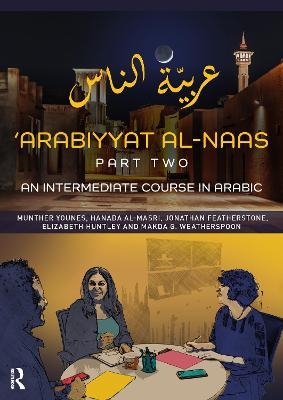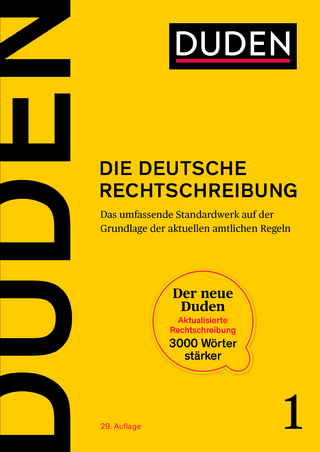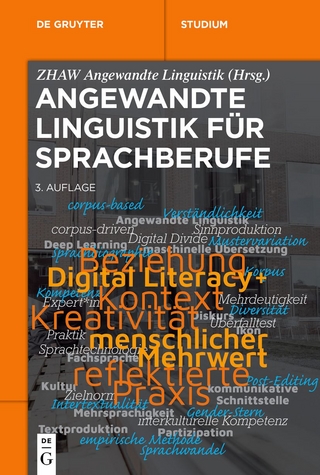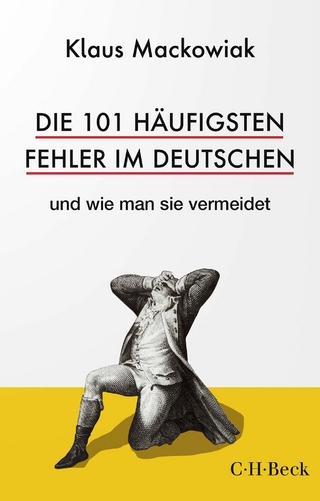
'Arabiyyat al-Naas (Part Two)
Routledge (Verlag)
978-1-138-35311-4 (ISBN)
Arabiyyat al Naas (Part Two): An Intermediate Course in Arabic, second edition, offers a vibrant course in Arabic as it is written and spoken today by educated native speakers.
It is a theme-based textbook delivered in the form of a serialized radio drama. Through the lens of journalism and personal interactions modelled by the main characters of this radio drama, learners are equipped to continue developing their spoken and written Arabic skills in the context of authentic dialogues and reading texts. As such, this book reflects cross-dialectal communication as used by native speakers across the Arab world.
Features include:
Twenty-one theme-based units covering a wide range of relevant and engaging topics
Thorough coverage of listening, speaking, writing and reading skills in every unit, with lessons structured to provide students with variety, stimulation and further opportunities for practice
Humorous, realistic dialogues reflecting everyday educated speech among Arabs to build up strong and practical communication skills
Free companion website (www.routledge.com/cw/younes) featuring extensive audio recordings of the listening materials in the textbook, videos that supplement the textbook, and texts of the listening passages in the textbook
Developed by an experienced and dynamic author team and tested over a number of years at Cornell University, Arabiyyat al Naas (Part Two) will be an essential resource for intermediate-level students of Arabic. While primarily designed for classroom use, the accessibility of the course also renders it highly suitable for independent study. Using the Common European Framework Reference, it takes the learner from B.1 to B.2 and, in terms of the levels of the American Council on the Teaching of Foreign Languages, it takes the learner from Intermediate Low to Intermediate High/Advanced Low.
This volume is the second in a pioneering three-part series of Arabic textbooks which together provide a complete three-year undergraduate language program.
Munther Younes is Reis Senior Lecturer of Arabic Language and Linguistics and Director of the Arabic Program at Cornell University. He is the co-author of the ‘Arabiyyat al-Naas textbook series and the author of the following books: The Routledge Introduction to Qur’anic Arabic, Kalila wa Dimna for Students of Arabic , The Integrated Approach to Arabic Instruction, and Charging Steeds or Maidens Doing Good Deeds: In Search of the Original Qur’an, all published by Routledge. He has also published numerous articles on Arabic linguistics, teaching Arabic as a foreign language, and the language of the Qur’an. Hanada Al-Masri is Associate Professor of Arabic in the Department of Modern Languages at Denison University, Ohio, where she teaches Arabic language and culture courses at all levels. She serves as Chair of the Department of Modern Languages and Director of the Middle East and North African studies program. Her research areas include translation theory and Arabic literary translation, discourse analysis, language attitudes, and Arabic language teaching and pedagogy. She is a certified ACTFL OPI tester since 2014. Dr. Al-Masri holds a PhD in linguistics from Purdue University (Indiana) as well as an MA in linguistics and a BA in English language and literature from the University of Jordan. Jonathan Featherstone is a great believer in the Integrated Approach. He has been teaching Arabic to non-native speakers for over 30 years. Jonathan has taught Arabic in the UK at the Foreign and Commonwealth Office, the Defence School of Languages and, more recently, at the University of Edinburgh as Senior Teaching Fellow. He is also a teacher trainer and has delivered workshops in Communicative Arabic Teaching in the UK, UAE, and US. He is also author of BBC Talk Arabic and co-author of Arabiyyat al-Naas fi Masr. Elizabeth Huntley is a current doctoral student in second language studies at Michigan State University. She holds master’s degrees in teaching Arabic as a foreign language and in Middle Eastern and North African studies from the University of Michigan. She has taught Arabic at the tertiary level at Cornell University and the University of Michigan, and at the pre-tertiary level with the Concordia Language Villages, the Middlebury-Monterey Language Academy, and the STARTALK Arabic Summer Academy of the Boston Public Schools. Makda G. Weatherspoon is Senior Lecturer of Arabic at Cornell University. She has also taught Arabic at the University of Washington and Middlebury Language Program in addition to working as a curriculum developer of online Arabic materials at the University of Cambridge Language Centre. Prior to teaching at the university level, she worked as an English instructor with refugees and immigrants preparing to take their US citizenship tests. Makda is the co-author of the following textbooks: Arabiyyat al-Naas fii Masr, Arabiyyat al-Naas (Part One) , and Arabiyyat al-Naas Part II, second edition.
المحتويات (Contents)
الوحدة الأولى: مقدّمات، تعارُف
Unit One: Introductions
الدرس الأول
النّص الأول (استماع): أحمد خالد
النصّ الثاني (قراءة): أحمد خالد
الدرس الثاني
النصّ الأوّل (استماع): مُنى شريف
قواعد (Grammar)
Expressing Possession with عند (in Levantine and Egyptian)
النصّ الثاني (قراءة) مُنى شريف
الدرس الثالث
النّص الأول (استماع): لمياء جمال الدين
قواعد
Arabic Plurals
النَص الثاني (قراءة): لمياء جمال الدين
قواعد
Verb Conjugation: The Past Tense (الفعل الماضي)
Noun-adjective phrases and Idafa phrases
الدرس الرابع: قراءة
السيرة الذاتيّة (أحمد ومُنى)
قواعد
Agreement in non-human plural nouns
الدرس الخامس
أغنية مُقترحة: علّي صوتك (محمّد منير) (CW)
Sociolinguistic Corner
Past Tense Verb Conjugations in Egyptian (مَصري), Levantine (شامي) and فُصحى
Question Words in فصحى, شامي, and مصري
الوحدة الثانية: العمل
Unit Two: Work
الدرس الأوّل: "كلّنا في الهوا سوا"
قواعد
How Many/Much (كم + المُفرد)
Subjects and Predicates: Verbless Sentences in Arabic
الدرس الثاني: عندي أسلوب جميل بالفصحى!
قواعد: قبل ما، بعد ما
الدرس الثالث: مذكّرات مُنى
قواعد
Verb conjugation: The Present Tense in MSA (الفعل المضارع)
Subject Markers, Object Pronouns, and the Stem of the Verb
The Stem (الصيغة المجرّدة)
الدرس الرابع: إعلان وظيفة - إذاعة "الشرق الاوسط "
الدرس الخامس
Sociolinguistic Corner
Expressing « to want » in شامي, مَصري , and فُصحى
Using ما عنديش/ما عندي
Present tense conjugation in فُصحى, مصري and شامي
الوحدة الثالثة: اللغة العربيّة
Unit Three: The Arabic Language
الدرس الأوّل: (نموذج من الارشيف) - مُقابلة مُنى مع رئيسة نادي أصدقاء اللغة العربية
قواعد
Stems, Roots, and Patterns (الصيغة المجرّدة والجذور والأوزان)
الدرس الثاني: (نموذج من الارشيف) - مُقابلة أحمد مع أستاذ صيني
قواعد
Root Types
Verb conjugations for different root types: Hollow and final-weak verbs
الدرس الثالث: قراءة - تاريخ العربيّة وعلاقتها باللغات الساميّة الأخرى
قواعد
The Comparative and Superlative in Arabic
Arabic Verb Formsأوزان الأفعال
الدرس الرابع: قراءة - العربية في العصر الحديث
قواعد
Verb Forms: VI, VII, and X
الدرس الخامس
أغنية مقترحة: الأرض بتتكلم عربي (سيّد مكّاوي) (CW)
Sociolinguistic Corner: Different words and expressions in فصحى, شامي and مصري
الوحدة الرابعة: السياحة والسفر
Unit Four: Travel and Toursim
الدرس الأوّل: حوار - حضرتك فاكراني؟
قواعد
Nouns derived from verbs (المصدر): The verbal noun
الدرس الثاني: مقابلة: مراكش – يا وردة بين النخيل!
قواعد
More on non-human plurals
The Active Participle (اسم الفاعل)
الدرس الثالث: قراءة - المواصلات في المغرب
قواعد
The Passive Participle (اسم المفعول)
الدرس الرابع: قِراءة - مدينة صنعاء عاصمة الثقافة العربيّة لعام ٢٠٠٤
قواعد
The فُصحى Case System
The Accusative Case (المنصوب)
الدرس الخامس
أغنية: وزارة السياحة ترحّب بكم!
Sociolinguistic Corner: همزة in فصحى, شامي and مصري
الوحدة الخامسة: الطعام والشراب
Unit Five: Food and Drink
الدرس الأوّل: حوار - كشري ولا مجدرة؟
قواعد
More on Negation in مصري and شامي: The use of عمري ما
الدرس الثاني: مُقابلة - أسرار تحضير الحمص
قواعد
The Ordinal Numbers 1-10(الأرقام الترتيبية)
The Imperative (الأمر)
Negating the Imperative
الدرس الثالث: قراءة
النصّ الأوّل: ديترويت عاصمة الأكل العربي في أمريكا
قواعد
More on إعراب : Use of the Accusative case after كم
Using تم with the مصدر
النصّ الثاني: مطبخ كبير لِسارة
الدرس الرابع
النصّ الأول: تاريخ القهوة
قواعد
The Passive Voice (المبني المجهول) in فُصحى
The Case System: Masculine Sound Plural and Dual جمع مذكر سالم والمثنى
النصّ الثاني: زيارتي لبيت أخي
قواعد
Verb Negationالنفي in فُصحى: the use of لا, لَم, and لَن
الدرس الخامس
أغنية: شاي كلّه سكّر (CW)
أغاني مقترحة
أهوى (اسمهان) (CW)
لا باكل ولا باشرب (سميرة توفيق) (CW)
تمرين رقم ١: استماع (نصّ إضافي): ليش ما بتاكلي لحم؟ اللحم زاكي.
الوحدة السادسة: الموسيقى العربيّة
Unit Six: Arabic Music
الدرس الأوّل: حوار - بتفضلي أم كلثوم ولا فيروز؟
قواعد: عجَب-يعجِب
الدرس الثاني: مقابلة أحمد مع الفرقة اللبنانية - مشروع ليلى
قواعد: شعر ب+ المصدر
Review of the Active Participle (اسم فاعل) , the Passive Participle (اسم مفعول), and the Verbal Noun (المصدر)
الدرس الثالث: قراءة - أصوات عربيّة
النصّ الأوّل: أم كلثوم
قواعد
More on the Passive Voice in فُصحى
النصّ الثاني: فيروز
قواعد
More on إعراب in فصحى: The five nouns (الأسماء الخمسة)
The Dual Form- أنجبا
الدرس الرابع: قراءة - أصوات عربيّة - الجزء الثاني
النصّ الأوّل: موسيقى الراي
النصّ الثاني: الشاب خالد
الدرس الخامس
قراءة إضافيّة: حمزة علاء الدين
الوحدة السابعة: المرأة العربيّة
Unit Seven: The Arab Woman
الدرس الأوّل: حوار - بدّي تحدّيات أكبر!
قواعد
The Imperative Revisited (الأمر – مراجعة)
الدرس الثاني: مقابلة منى مع لمياء عن زها حديد
قواعد
Forming the Verbal Nouns المصدر with hollow and final-weak roots
Nouns with an Initial ميم
الدرس الثالث: قراءة
مُجاهدات في صمت – علياء
قواعد
The Accusative Case Revisited: Accusative of the Absolute (المفعول المطلق)
الدرس الرابع: قراءة
مُجاهدات من أجل حقوق الإنسان!
النص الاول: تَوكّل كَرمان
النص الثاني: صفاء العاقب
الدرس الخامس
قواعد
The Relative Pronoun Revisited
قراءة إضافيّة: نساء عربيّات
الوحدة الثامنة: السياسة وحقوق الإنسان
Unit Eight: Politics and Human Rights
الدرس الأوّل: حوار - لقاء منى مع لمياء: نضرب عصفورين بحجر!
قواعد
Review of Feminine Plurals, Human and Non-Human
Spelling Changes in Form VIII Verbs (اصطناعي، ازدهار، ازدحام، اضطهاد)
The Adjective "favorite" (مُفضَّل)
الدرس الثاني: مُقابلة منى مع ناشطة مغربية
قواعد
The Connectors ف and و
Adding Adjectives to Construct Phrases
الدرس الثالث: قراءة
حملة اعتقالات شَرِسة في مصر
قواعد
Negation Using the Particle غير
الدرس الرابع: استماع وقراءة
تعدّدت الأسماء والحُكم واحد!
قواعد
The Connectors ليسَ ... الّا، ليس ... بل
Moods of the Present Tense Verb
Demonstrative Pronouns in فصحى ((هذا، هذه، هؤلاء، ذلك، تلك
الدرس الخامس
Sociolinguistic Corner: The Particle أيّها
قراءة إضافيّة
Sociolinguistic Corner
The Particle أيّها
الوحدة التاسعة: الاقتصاد
Unit Nine: The Economy
الدرس الأوّل: حوار- أحمد ومنى - عقد عمل دائم
قواعد
Assimilated Roots (ثِقة)
لأنّ، بِسبب
الدرس الثاني: حوار- لمياء مع أحمد ومنى - مشروع مُشترك
الدرس الثالث: قراءة
: البطالة والسياحة في عُمان
قواعد
Relative Pronouns in فصحى: الذي، التي، الذين
الدرس الرابع: نصف الأموال مُخزونة في المَنازِل... لماذا يرفض العراقيون وضع أموالهم بالبنوك؟
قواعد
Using the Particles إنّ/أنّ
More on Spelling Changes in Verb Patterns Derived from Defective Roots
Form VI
الدرس الخامس
أغنية مقترحة: "كنّا وكنتوا" (جيل جيلالة) (CW)
Sociolinguistic Corner
عَشان، عَلى شان، لِأنّ، بسبب، من أجل
إنّ/إنُّه
الوحدة العاشرة: القانون والنظام
Unit Ten: Law and Order
الدرس الأوّل: حوار- عمّي محامي كبير!
قواعد
The Returning Pronoun (الضمير العائد)
الدرس الثاني: مقابلة - المحاكم حبالها طويلة!
قواعد
The تاء مربوطة as an ‘individualiser’
The Verb بدأ and the مصدَر
The مصدر of Form III verbs derived from final-weak roots
الدرس الثالث: قراءة
تونسيات يطالبن بتعدّد الزوجات
قواعد
The third person feminine plural pronoun هُنَّ
Future Marker (سوف / س) in فُصحى
لَم يدعُ
The Particles إنّ and أنّ (Review)
الدرس الرابع: قراءة
اللصوص والشرطة والقانون
النصّ الأوّل: دخل ليسرق المطعم فسكر ونام
النصّ الثاني: لِصّ يفرح لرؤية الشرطة!
قواعد
The Deletion of نون of إضافة
النصّ الثالث: ساعِدني حتى أهرب بمالِك!
قواعد
The Dual (المُثنّى) in فصحى
Conjugation of the verb أعطى in the present tense
النصّ الرابع: خاتم وبيتسا أيضاَ!
الدرس الخامس
أغنية: اشرب واسكر عالقانون (CW)
أغنية مقترحة: سرقوا موبايلي (محمّد صالحين) (CW)
Sociolinguistic Corner: قبل أن، بعد أن
الوحدة الحادية عشرة: الصحّة
Unit Eleven: Health
الدرس الأوّل: حوار - ما فيش أكل عربي!
قواعد
The Use of كان with the Active Participle in Arabic
الدرس الثاني: حوار - لازم ترتاح في البيت!
قواعد
Moving to the past with كان
الدرس الثالث: قراءة
لا مستشفى ولا طبيب!
قواعد
١. لم ... بل
٢. أمّا ... ف ...
More on the Accusative Case: Adverbials of Time and Manner
الدرس الرابع: قراءة
الإنفلونزا: الأعراض، الانتشار، العلاج، والوقاية من المرض.
قواعد: إمّا ...أو
الدرس الخامس
Sociolinguistic Corner: Possession with بتاع or تبع
الوحدة الثانية عشرة: الرياضة
Unit Twelve: Sports
الدرس الأوّل: مقابلة - محمد صلاح نجم كرة القدم
الدرس الثاني: مقابلة مُنى مع العَدّاءة المغربيّة الشابّة غزالة رُشدي
الدرس الثالث: قراءة
النصّ الأوّل: الرياضة في العالم العربي
قواعد
Accusative of Specification (التمييز)
ما التعجب!
النصّ الثّاني: الفريق السوري لِكرة القدم يتعافى من كورونا
الدرس الرابع
النصّ الأّول: مصر تتأهّل لمُنافَسات الكرة الطائرة بأولمبياد البرازيل
قواعد
The Dual (المثنى): Review
النصّ الثاني: شاهد.. شبيه ميسي يحصد الشهرة في العراق
قواعد
Ordinal Numbers: Review
Negation of the Future with لن
الدرس الخامس
أغنية: محمّد صلاح يا فخر المصريّين (خميس ناجي؟؟؟) (CW)
Sociolinguistic Corner: قَوي، كثير، جدّاً
الوحدة الثالثة عشرة: فلسطين
Unit Thirteen: Palestine
الدرس الأوّل: حوار: عائلتي من أصل فلسطيني!
قواعد
The Root and the Stem (الجذر والصيغة المجرّدة)
الدرس الثاني: مقابلة: صفقة القرن
الدرس الثالث: قراءة
تاريخ فلسطين
قواعد
Ordinal Numbers (11-20)
More إعراب practice
الدرس الرابع: قراءة
النّص الأول: محمود درويش- شاعر فلسطين
أمثلة من شعر محمود درويش Samples from Mahmoud Darwish’s poetry))
النَص الثاني: إدوارد سعيد
الدرس الخامس
أغنية: القائد والقرصان (CW)
أغنية مقترحة: منتصب القامة أمشي (مارسيل خليفة) (CW)
Sociolinguistic Corner: I miss you in مصري and شامي
الوحدة الرابعة عشرة: الأعراق والأديان في العالم العربي
Unit Fourteen: Ethnicities and Religions in the Arab World
الدرس الأوّل: حوار - المجتمع النوبي له عاداته وتقاليده!
قواعد
The Use of لو with the Conditional in مصري and شامي
الدرس الثاني: مقابلة - المجتمع الشركسي فخور بثقافته الأصلية!
الدرس الثالث: قراءة
النصّ الأوّل: تنوّع السكان في العالم العربي
النصّ الثاني: ١٨ طائِفة مُختلِفة
قواعد
Connectors ( أدوات الربط)(رغم ... ف), (بالنسبة ل...) and (نتيجة ل)
Nisba Adjectives of Nationalities (Plural)
الدرس الخامس
أغنية: بلادي مَوطِن العُرْب (CW)
Sociolinguistic Corner: بقى لي، صار لي في المصري والشامي
الوحدة الخامسة عشرة: الأعياد والاحتفالات
Unit Fifteen: Festivals and Celebrations
الدرس الأول: حوار - لقاء أحمد ومنى عبر الفيديو- "انتِ كريمة... وأنا باستاهل!
الدرس الثاني: حوار - لقاء أحمد ومنى -ذِكريات العيد
الدرس الثالث: قراءة
النصّ الأوّل: الأعياد الإسلاميّة
قواعد
حَيْثُ
أمّا ... فَ
النصّ الثاني: الأعياد والمناسبات المصريّ
قواعد
Word Order in the Arabic sentence
الدرس الرابع: قراءة
عيد الميلاد - بين الاحتفالات وأجواء الحزن
قواعد
More on verbal nouns derived from verbs based on weak roots
الدرس الخامس
أغاني مقترحة
ليلة عيد (فيروز) (CW)
الليلة عيد (أم كلثوم) (CW)
Sociolinguistic Corner
باتذكّر، فاكِر
مثل ما، زيّ ما، لغاية ما
لَمّا، عندما
الوحدة السادسة عشرة: الهجرة واللاجئون
Unit Sixteen: Migration and Refugees
الدرس الأوّل: حوار: الغُربة مُرّة!
قواعد
The Prepositions عن and على
الدرس الثاني: مقابلة: كان عندي مشكلة في الكلام اليومي!
الدرس الثالث: قراءة
النص الأوّل: ما هي الشروط الجديدة للهجرة إلى بريطانيا؟
قواعد
The Particle مَن
النص الثاني: ما هو حق اللجوء السياسي؟
قواعد: أدّى إلى، نتَج عنه
الدرس الرابع: قِصّة في غاية الحُزن!
الدرس الخامس
أغنية مقترحة: وهران (الشاب خالد) (CW)
Sociolinguistic Corner: ترك/يترُك vs. ساب/يسيب "to leave"
الوحدة السابعة عشرة: البيئة
Unit Seventeen: The Environment
الدرس الأول: حوار - فريق ممتاز!
قواعد
The b- Prefix with the Present Tense in شامي and مصري
الدرس الثاني: حوار - المنظر ده ساحر وعجيب!
الدرس الثالث: قراءة
المؤتمرالوطني الأول للبيئة والتنمية
قواعد
Using كثير مِن and الكثير مِن
الدرس الرابع: قراءة
تحذيرات عربية من نقص المِياه
الدرس الخامس
Sociolinguistic Corner: The Verb خلّى/يخلي
الوحدة الثامنة عشرة: الزواج
Unit Eighteen: Marriage
الدرس الأوّل□:حوار: لقاء أحمد مع عائلة منى في الأردن- الأخ مصري؟
الدرس الثاني□:حوار - حديث منى مع عائلتها في الأردن – وجع رأس!
قواعد
Active Participles of Verbs Based on Weak Roots
Hollow Roots
Doubled Roots
الدرس الثالث: قراءة
قلبي على ولدي وقلب ولدي على الحَجَر!"
قواعد
لا النافية للجنس ( of Absolute Negation لا)
الدرس الرابع: قراءة
حياتي ومستقبلي
الدرس الخامس
أغنية مقترحة: مش هتنازل عنك أبدا مهما يكون (سميرة سعيد) (CW)
The Sociolinguistic Corner: The Plural of أخ in مصري and شامي
| Erscheinungsdatum | 16.12.2020 |
|---|---|
| Zusatzinfo | 389 Tables, black and white; 71 Halftones, color; 71 Illustrations, color |
| Verlagsort | London |
| Sprache | englisch |
| Maße | 210 x 297 mm |
| Gewicht | 1500 g |
| Themenwelt | Schulbuch / Wörterbuch ► Wörterbuch / Fremdsprachen |
| Geisteswissenschaften ► Sprach- / Literaturwissenschaft ► Sprachwissenschaft | |
| Sozialwissenschaften ► Soziologie ► Spezielle Soziologien | |
| ISBN-10 | 1-138-35311-6 / 1138353116 |
| ISBN-13 | 978-1-138-35311-4 / 9781138353114 |
| Zustand | Neuware |
| Informationen gemäß Produktsicherheitsverordnung (GPSR) | |
| Haben Sie eine Frage zum Produkt? |
aus dem Bereich


